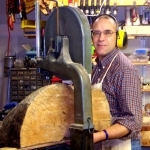I just found a bunch of Makore wood for a good price. Says here it has a high silica content. How do you think it compares with White Oak, Epe, Teak, Cypress and Mahogany for making outdoor furniture???
MAKORE
(Tieghemella spp.)
OTHER COMMON NAMES: Makore, douka, baku, ukola, African cherry, cherry mahogany
SPECIFIC GRAVITY: 0.55
DENSITY: 42 pcf
TANGENTIAL MOVEMENT: 6.8 to 8.0%
RADIAL MOVEMENT: 4.7 to 6.2%
VOLUMETRIC SHRINKAGE: 10.6 to 11.0%
DURABILITY: Excellent
SOURCE: East Liberia, Sierra Leone to Cameroon, Gabon to Cabinda
DESCRIPTION: It is a solid wood that is favorably used for intarsia and decorative veneers due to its irregular growth patterns. The heartwood is pink to pinkish brown, with an soft appearance of tan streaks throughout. The sapwood can be up to 4.5 inches thick and is light pink or off-white in color. Fair workability using hand and machine tools. Blunting of cutting edges is caused by a high silica content. Glues and finishes well. Note: Nose and throat may be irritated by fine dust. Used for joinery, cabinetry, furniture, boat construction, flooring, and turnery.
















Replies
I have not worked with it, but mesquite also has a high silica content and dulls blades very quickly. If using hand tools, make sure that they are freshly sharpened.
If you are using power tools, use either a new or freshly sharpened blade. If not you may get some burning and in any case, you may have to have blades sharpened when done and with hand tools, may have to resharpen or hone them more often than usual.
Jb,
Ihave used about 5 cubic metres of makore in the past to make indoor furniture like chests,beds etc.
Ican confirm that it is extremely abrasive, in fact the most abrasive I have ever encountered, although it is not at all hard. Don't know why your source says "fair workability"-it is easy to work with hand tools providing you strop and sharpen very much more than usual and tungsten is a must with machines.Some people are just unable to take the dust.
As for outdoor use, I know it is durable but have never put it to that use:I think it would be a waste to do that and there are other timbers that look better under oudoor conditions.
Isuggest you play with a few pieces first-because of the dust irritation factor, and you'll also see about the abrasiveness.
I agree with phillip, in that I think it is too nice a wood for most outside applications. Some of the projects that I have used it on, I bought fiddleback veneer for the panels, and or top surfaces. Here is a source if you have never seen it fiddleback or other figures. It is one of the best.
http://www.certainlywood.com/newarrivals/HotMakore-03.htm
http://www.certainlywood.com/newarrivals/QMakore-Moabi-03.htm
I left off the fiddleback photo, because it didn't look as good as what I have gotten in the past.
Yes Keith, it is awesome when quilted or fiddleback.
However I would bet my life that he won't find any but the ordinary Makore in that "pile"-unless he is unusually lucky.
The stuff I had was prime grade and mostly quarter sawn,some boards having that #### (spelling?).
I would have a guilty conscience if I used it for any outdoor application-it is not called African Cherry for nothing.
The dust could be the deciding factor for JB-he may just be unable to tolerate it.
i've done several pieces with makore and it is a beautiful wood - finishes wonderfully - but it is the only wood i have ever had a reaction to - just after a few cuts it does my sinuses in - have had to stop using it completely.
i tried to attach a picture of a cabinet -jerry
This forum post is now archived. Commenting has been disabled